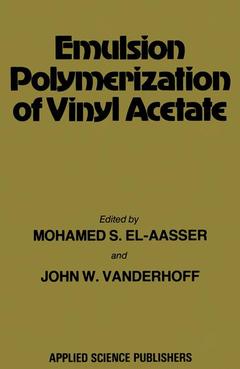Description
Emulsion Polymerization of Vinyl Acetate, Softcover reprint of the original 1st ed. 1981
Coordinator: El-Aasser Mohamed S.
Language: English
Keywords
Publication date: 01-2012
290 p. · 14x21.6 cm · Paperback
290 p. · 14x21.6 cm · Paperback
Description
/li>Contents
/li>
It is particularly appropriate that this symposium on the emulsion polymeriza tion of vinyl acetate was held in recognition of the industrial importance of poly(vinyl acetate) and vinyl acetate copolymers, and their rather unique properties among emulsion polymers in general. Poly( vinyl acetate) latexes were the first synthetic polymer latexes to be made on a commercial scale: their production using polyvinyl alcohol as emulsifier began in Germany during the mid-1930s and has continued to the present day, growing steadily with the years. Indeed, poly(vinyl acetate) latexes prepared with polyvinyl alcohol are still one of the mainstays of the adhesives industry. With the passing of time, however, vinyl acetate copolymers have been developed: copolymers with maleate esters such as dibutyl maleate, acrylate esters such as ethyl acrylate and butyl acrylate, versatic acid esters, and, more recently, ethylene. These versatile copolymers have found increasing use in more sophisticated adhesives with specialized properties, adhesives for clay coatings on paper, carpet backing, and interior and exterior paints. Thus more than 45 years after the first commercial production of vinyl acetate latexes, their use is still growing, both in actual quantities and different applications. The industrial importance of vinyl acetate latexes makes the mechanism and kinetics of their emulsion polymerization of practical as well as scientific interest.
1. Frontiers Between Theory and Industrial Practice in Vinyl Acetate Polymerizations.- 2. The Polymerization of Aqueous Solutions of Vinyl Acetate.- 3. Effects of Particle Number and Initiator Level on the Kinetics of Vinyl Acetate Emulsion Polymerizations.- 4. Synthesis Kinetics and Characterization of Poly(Vinyl Acetate)- Molecular Weight and Long Chain Branching Development.- 5. Some Surface Chemical Effects on the Capture of Free Radicals-A Kinetic Parameter Analysis of the LPS Model.- 6. The Reinvestigation of Vinyl Acetate Emulsion Polymerization (I)- The Rate of Polymerization.- 7. The Reinvestigation of Vinyl Acetate Emulsion Polymerization (II)-The Induced Decomposition of Initiator.- 8. The Reinvestigation of Vinyl Acetate Emulsion Polymerization (III)-Isotope Effect.- 9. The Radiation Induced Emulsion Polymerization of Vinyl Acetate.- 10. The Stabilization of Poly(Vinyl Acetate) Latexes by Polymethacrylic Acid.- 11. Particularities of Emulsion Polymerization of Vinyl Acetate in the Presence of Hydroxyethylcellulose.- 12. Preparation, Characterization and Properties of Vinyl Acetate- Butyl Acrylate Copolymer Latexes.- 13. Some Studies on Vinyl Acrylic Latex-Surfactant Interactions.
© 2024 LAVOISIER S.A.S.




